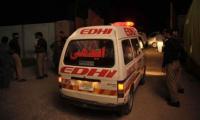ISLAMABAD: The ranks of US workers laid off at least temporarily by the coronavirus pandemic exceeded 42 million, with 1.87 million new jobless benefit claims filed last week, the Labor Department said.
The number of new claims filed in the week ended May 30 were slightly worse than expected but 249,000 less than the week prior, indicating the unprecedented layoffs were slowing, international media reported. "This and other indicators suggest not that the job market is improving but that it´s getting bad less quickly," tweeted Jared Bernstein, senior fellow at the Centre on Budget and Policy Priorities think tank, noting this week´s claims were 2.7 times higher than the previous one-week record.
The insured unemployment rate indicating the number of people actually receiving benefits ticked up half a point to 14.8 percent the week ended May 23, with 21.5 million people receiving benefits. That indicated fewer people were returning to work after last week´s report showed the rate of people receiving benefits decreasing, perhaps from the impact of states allowing businesses to reopen.
The weekly government data comes ahead of the Labor Department´s monthly unemployment report due out Friday, where April´s 14.7 percent unemployment rate is set to head further upwards. "National unemployment rate is likely at or above 20 percent, twice that of the Great Recession peak and full employment years away," Bernstein said. Meanwhile, the Red Cross on Thursday called on US authorities and those leading the demonstrations raging across the country to help ensure protesters can gather without fear of sparking fresh coronavirus outbreaks.
Protesters have been thronging cities across the United States demanding an end to racism and police brutality ever since George Floyd, an African American man, died after being pinned down by police officers more than a week ago. But in the midst of the coronavirus pandemic, Red Cross leaders are calling on officials and protest leaders to do more to ensure that the demonstrations can go ahead safely with regard to the COVID-19 virus.
"It is about common sense," Francesco Rocca, President of the International Federation of the Red Cross and Red Crescent Societies (IFRC) said.
He lamented that television images of the protests showed many marching without wearing masks or other protective gear such as gloves, and pressed together is small spaces.
"This is a bad signal, of course. And of even more concern in a country that is having this bad impact with COVID-19," he said.
The United States remains the country worst affected by the pandemic, counting more than 109,000 deaths -- more than a quarter of the global total. More than 1.9 million people in the country have been infected.
Rocca called on protest organisers and leaders to set a good example, and to frequently remind participants of the importance of adhering to basic safety measures like physical distancing and wearing protective gear.
"We are not telling anyone not to demonstrate, not to show their frustration in a peaceful manner, but really to protect the others," he said.
"When you say black lives matter, that all the lives matter, this is a way to show respect for lives."
IFRC´s health chief Emanuele Capobianco meanwhile stressed the role of the authorities in facilitating peaceful protests and helping to minimise the risk of virus transmission.
"Authorities should try to persuade and to help the demonstrators to do it in a safe way," he said.
"We want people to be protected as much as possible. We also want people to be listened to."
Rocca meanwhile lamented the difficulty of addressing best practices for containing the coronavirus, be it amid protests or otherwise, without being accused of "politicising".
"This is not about politics," he insisted, stressing his organisation´s dedication to political and ideological neutrality.
Such charges sit loosely when discussing the situation in the United States, but also elsewhere, like in Brazil, where President Jair Bolsonaro has staunchly opposed lockdowns even as numbers of cases and deaths have skyrocketed.
"Brazil is at the top of our concern," Rocca said.
"Too many are dying, and there are no evident signals that the curve is going to slow down."
Meanwhile, Sweden said it would provide free testing for anyone showing coronavirus symptoms and conduct contact tracing for those who are infected.
The announcement came as the country said it would also allow domestic travel across the country, almost three months after it was discouraged in line with anti-virus measures. The aim of the new testing program is to control infection rates in the country, which did not impose strict lockdown measures like many of its European neighbours.
The government said it would dedicate 5.9 billion Swedish kronor ($640 million), in addition to a billion kroner already promised, to cover the costs of testing and contact tracing.
"From now on, everyone with symptoms will be able to test themselves for COVID-19 free of cost," Minister for Financial Markets Per Bolund told reporters.
Meanwhile, Canadian Prime Minister Justin Trudeau declared on Thursday that Canada is winning the fight against the new coronavirus, with the latest data showing new cases in decline.
But he also warned that the battle is not over yet.
"The data shows that we are continuing to make progress in the fight against this virus in many communities, the number of new cases is low, and we can trace where they came from," Trudeau told a daily briefing.
"That´s an encouraging sign that the virus is slowing, and in some places, even stopping," he said. "But I want to be very clear: We´re not out of the woods."
As of Thursday there were 93,700 coronavirus cases in Canada. More than half of those patients have already recovered.
New COVID-19 modeling for the country showed the epidemic has slowed after peaking mid-April.
And with strong containment measures -- such as social distancing, testing and contact tracing -- Canada could slay the virus by fall.
In the short term, Health Canada projects the total number of cases to rise to between 97,990 and 107,454, -- including 7,700 to 9,400 deaths -- by June 15.
Canada flattened its epidemic curve sooner than a number of countries such as Britain, Italy and the US, but lagged behind South Korea and Japan.







